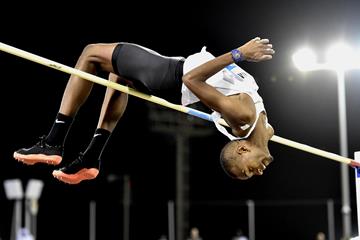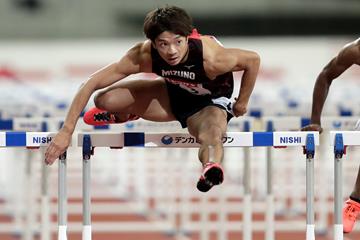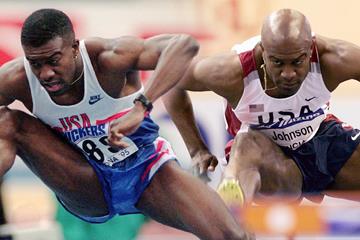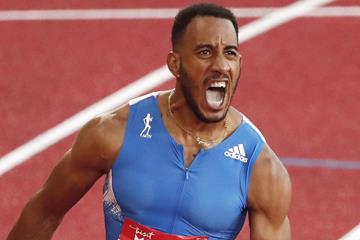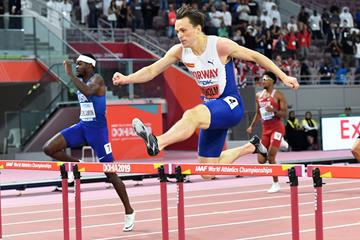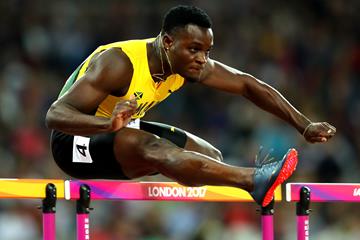 Countdown
Countdown
 Countdown
Countdown
The 110m hurdles is a men’s event that involves clearing 10 hurdles spaced at set distances along a straight 110-metre track. The goal is to sprint from the start line to the finish line in the shortest time possible.
Created in England in the 1830s, the earliest form of this athletics hurdles event featured wooden barriers placed along a track
The distance was extended to 120 yards by the universities of Oxford and Cambridge
The current distance of 110 metres was established by the French in 1888
The 110m hurdles has been contested at every modern Olympics since the inaugural Games in 1896
The women’s version of this event is the 100m hurdles
The first recognised 110m hurdles world record was 15.0 seconds. It was set by Forrest Smithson of the United States in 1908. It took 12 years for another competitor to beat Smithson’s record. He was finally dethroned by Earl Thomson of Canada, who completed the hurdles in 14.8 seconds in 1920.
The next notable advancement was made by another Forrest. Forrest Towns of USA set three consecutive records in 1936, the third of which was 13.7 seconds. This was the first time somebody had run the 110m hurdles in under 14 seconds. More than four decades later, USA’s Renaldo Nehemiah shaved another 0.77 seconds off the world record. He cleared all 10 hurdles in just 12.93 seconds in 1981.
In recent years, US athletes have dominated in the sport and topped the world rankings. This includes decorated athletes like Grant Holloway, Allen Johnson and Aries Merritt.
Today, the men’s 110m hurdles world record is held by Merritt. He ran a time of 12.80 seconds at the 2012 Diamond League final. This makes him the fastest 110m hurdles athlete of all time.
The world of 110m hurdles is filled with outstanding athletes. Among the most remarkable is Colin Jackson (Great Britain). The only Briton to achieve a world record in this discipline, Jackson’s 110m hurdles performances helped him earn his place in the history books.
Jackson set his record (12.91 seconds) at the 1993 World Championships. It took more than 10 years for his time to be beaten. On top of this, he was the undefeated European champion between 1990 and 2002, he claimed silver at the 1988 Olympics, and he won a further world title in 1999.
Like Jackson, Liu Xiang is the only Chinese athlete to achieve a world record for the 110m hurdles. The Olympic gold medallist (2004) and world champion (2007) set two consecutive records: 12.91 in 2004 and 12.88 in 2006. He was the event’s greatest athlete until 2008, when Dayron Robles (Cuba) beat his time by 0.01 seconds.
In the history of the 110m hurdles, one nation has outperformed the rest: the USA. They snared 18 gold medals across the first 23 editions of the Olympics, including two apiece for Lee Calhoun and Roger Kingdom. However, their progress has slowed in recent years. The USA claimed one solitary gold between 2000 and 2021.
Athletes who compete in the 110m hurdles must possess speed, agility and precision. They must also master the sprinting hurdles technique, which includes:
A precisely-timed start
A powerful approach to the first hurdle
Clearing all 10 hurdles
Sprinting and maintaining pace between hurdles
Let’s take a closer look at the 110m hurdles technique.
The start of the 110m hurdles is fast, precise and explosive. The athletes must generate maximum power and accelerate from the starting block towards the first hurdle. Top-performing male hurdlers like Aries Merritt and Liu Xiang complete this initial 13.72m sprint in seven steps.
The athlete aims to reach full speed by the time he approaches the first hurdle. To do this, he must maintain a strong, upright posture and focus on his stride pattern.
Clearing the hurdles efficiently is a crucial aspect of the 110m hurdles technique. The competitor leads with his dominant leg, extending it straight over the hurdle while bending the back leg towards his body. The lead leg passes over the hurdle with minimal clearance, helping the athlete to maintain his momentum.
Sprinting between hurdles requires a consistent rhythm. Each space measures 9.14m and most hurdlers take three steps between each hurdle.
The 110m hurdles ends with the final sprinting technique. The athlete clears the 10th hurdle and he must sprint the last 14.02m to the finish line. These events are often decided by fractions of a second and a strong finish can mean the difference between victory and defeat.
The 110m hurdles event is governed by a set of rules. These include:
Athletes must start from the blocks and use the same leg over each hurdle
Competitors must not leave their designated lane
Hurdlers must not intentionally knock over hurdles
Every athlete must clear all of their hurdles
If a competitor breaks any of these rules, he could be disqualified. There are several examples of a DQ in the 110m hurdles. These include but are not limited to: venturing into another competitor’s lane and obstructing him, deliberating knocking down a hurdle or committing a false start.
Starts are measured by sensors in the starting pistol and on the blocks. A reaction time of less than 0.1 seconds is deemed a false start. If this occurs, runners are recalled and the responsible athlete is disqualified from the event.
At elite-level championships, the men’s 110m hurdles begins with the heats and each athlete performs one run per round. The top athletes from each heat progress to the semifinals and the event culminates in the final. The finishing order is determined by time.
Hurdles in the 110m hurdles are knocked down easily if touched and there’s no penalty as long as they’re knocked over accidentally. However, if a hurdle is knocked over on purpose in order to gain advantage, the offending competitor is disqualified.
The men’s 110m hurdles was standardised in line with the average height and stride of male hurdlers. Whereas, the women’s 100m hurdles event is a shorter distance in order to accommodate for the average height and stride of female athletes.
The height of each hurdle in the men’s 110m hurdles is 106.7cm (42 inches). This height was introduced in 1864, when the universities of Oxford and Cambridge attempted to standardise the sport.
The distance between each hurdle in the men’s 110m hurdles is 9.14m (30 feet). The exceptions are the first and last hurdles: there is a distance of 13.72m (45 feet) to the first hurdle and 14.02m (46 feet) from the final hurdle to the finish.
There are 10 hurdles in the 110m hurdles event. The length of 110 metres covers the distance from the start block to the finish line and athletes must successfully clear all 10 hurdles.
Yes, a hurdle can be knocked over in the men’s 110m hurdles and they are positioned to allow them to fall over if knocked. In such a fast-paced event, it’s common for a hurdler to touch and accidentally knock over a hurdle.
 USA
USA
 JPN
JPN
 ESP
ESP
 USA
USA
 JAM
JAM
 SUI
SUI
 USA
USA
 USA
USA
 USA
USA
 USA
USA
